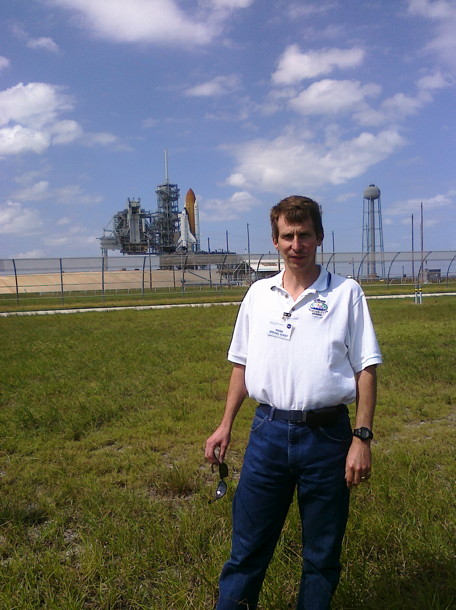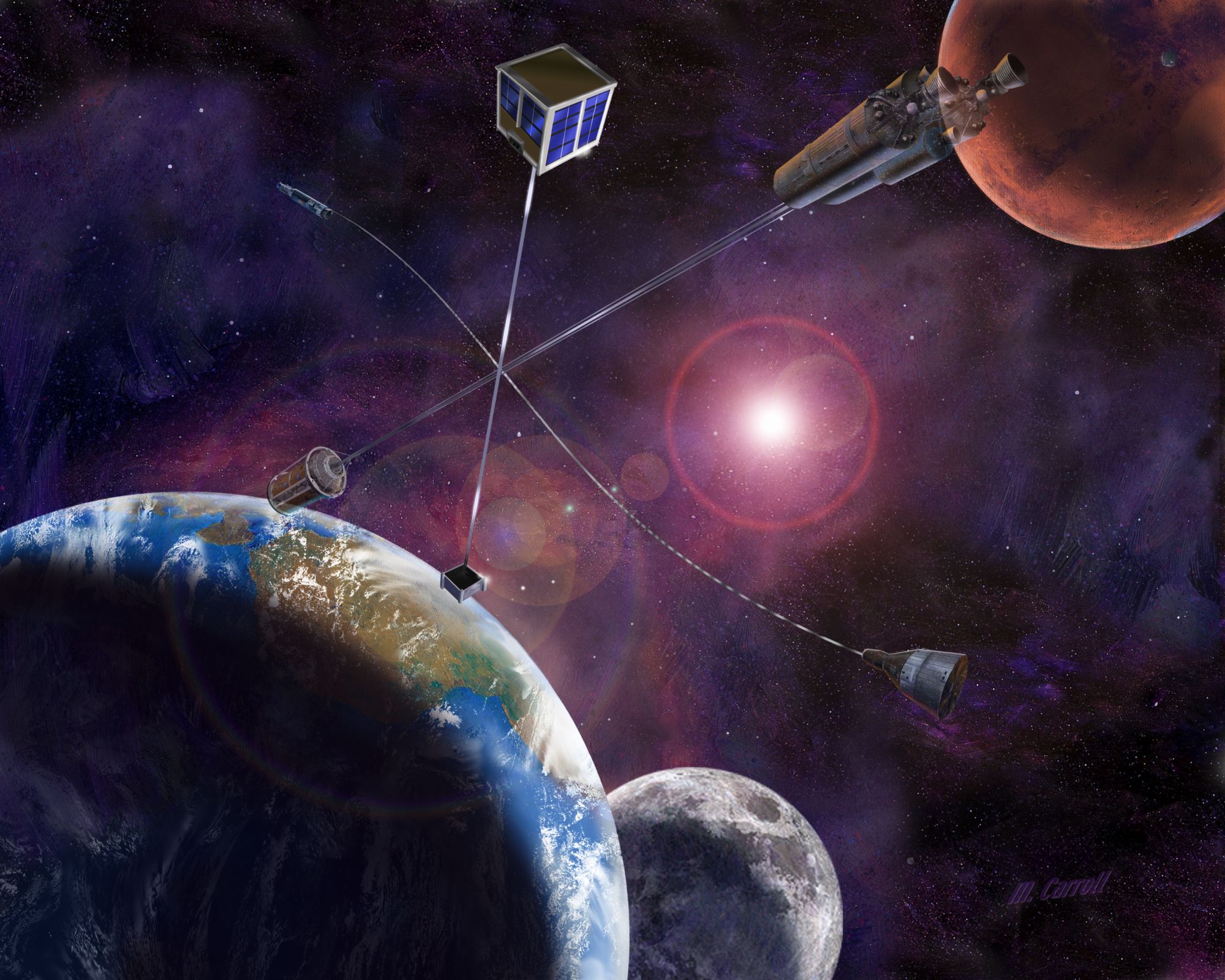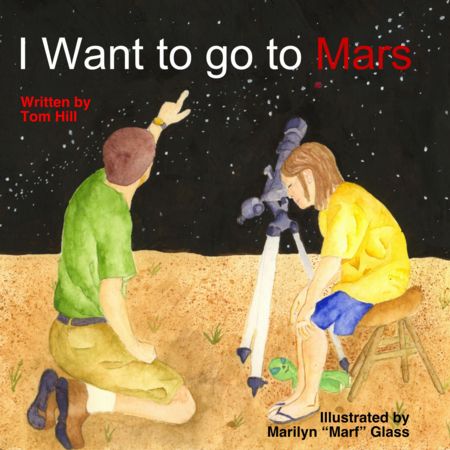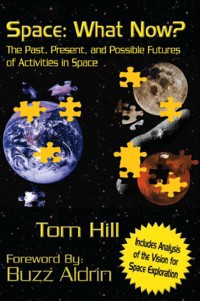|
|
 |
|
Here's the latest on space, and my opinions on it... This is the legacy site, with blog
entries from November, 2004 through June, 2011. Updates after June 9, 2011 can be found at http://spacewhatnow.com/SWN
|
 |
|
|
Tuesday, February 27, 2007
Look Ma! No Major Damage
Apparently, some people ( here for example) thought that the Sea Launch explosion spelled near-certain doom for the launch platform. Rocket explosions look amazing, with all the fuel and oxidizer
burning rather quickly, but they're often confused with a detonation, as happens when a bomb goes off. Turns out, the launch
platform has returned to port, and it doesn't look so bad. I guess I should have put an entry up stating that would be the case (I just have a
comment on Rand's site), so I could bask in the glow of having 'called it'
Lotsa Little Pieces
Here is a web page showing the orbital elements of all the pieces being tracked from the China ASAT test. Note that each piece
gets a letter. When they run out of letters, they go to two letters, then three. If they ever have to go to four letters,
a breakup would have to go into more than 17,000 pieces. Here's hoping that never happens. Of course, hope is kind of what
our space defenses rely on right now...
9:33 pm est
An Early Envisioned (Eventually) Successful Asteroid Deflection Mission
In 1968, not many people were thinking of asteroid defense. The primary sci-fi TV show of the day gave us a preview,
however, and that episode has just been broadcast in remastered form. The Paradise Syndrome focuses more on Kirk's relationship (duh...) but the efforts the Enterprise make to push the asteroid are remarkably
true to what needs to happen, while the attempt to split it is questionable, it makes for some cool story. I would hope
that they'd have more than a couple months warning for such a mission, but The Federation is pretty busy, I'm sure...
Be sure to check out the comparison pictures between the old version and the enhanced version. The old effects
were pretty good. I guess the coolest thing they could have added was a tumbling rock, though I didn't think about how
it would have fit in with the dialog as I watched it.
Monday, February 26, 2007
Sweet Shot
Here's an image taken by the Rosetta spacecraft as it flew past Mars. While pristine pictures of just the planet are the norm,
there's something awesome about seeing parts of the human construct that took the picture.
Sometimes, I'm awed by what humans can accomplish. Other times, I'm horrified by what humans can accomplish.
5:08 am est
Sunday, February 25, 2007
I feel Better
Here is a post by a Sci-fi writer on his cashflow in the practice. I'm a few years back on his curve, and mixing my writing
forms.
Saturday, February 24, 2007
"Where are the Yanks?"
Some thoughts on The UN, Apophis, and Iraq from Lileks.
I find it kinda cool how various space-related news items (like Apophis' 1 in 45,000 chance of hitting Earth in 2036) get
dropped into comentaries.
Glad I don't work in Contracts!
The Request for Proposal for the Ares I upper stage hit the street yesterday. This is the formal document where NASA (or any other government agency) says "Tell
us how you'd build something and how much it would cost, and we'll choose the best plan." At least in theory. Potential
builders have seen drafts of this document in the past, and the cover letter describes changes. Anyway, I downloaded sections
A-I, to see what was specified about the stage's performance. Nothing jumped out at me as being related to performance or
size, so I did a word search for "mass." No dice. Searches for "kg" and "thrust" were negative too. I'd like to think that
the terms are in one of the documents, (there are more than 40) and if I knew more about contracting I could probably pick
the one on sight, but I'm not that interested.
Update: I wasn't quite happy with being unable to find anything, so I poked around a little more and found section J-6, which
lists applicable documents. Unfortunately, a quick web search for the "Upper Stage Element Requirement Document" publication
ID came up blank.
Friday, February 23, 2007
Work on Mars Images
There's a system in beta-testing called Clickworking. In it, you can view data coming from MRO in search of certain landforms. I haven't tried it yet, but heard good
things from a friend who did.
The blog entry which pointed clickworking out to me pointed out another effort used to find near-Earth asteroids. Unfortunately, the effort's been discontinued, but you can still take the tutorial
and test, getting all checked out and ready. I'm saving you some time, because I got the whole way through testing before
trying to 'go live' and getting told that I was out of luck.
Big Potential Doin's at L1
Here's an interview between Alany Boyle and Robert Bigelow. In it, Mr. Bigelow talks about his next goal, assuming his low
Earth orbit operations continue as well as they have. His goal is the Lagrange Point between Earth and the Moon. NASA looked at this as one waypoint in early architecture studies related to the Vision
for Space Exploration, but that has changed since Mike Griffin took the helm at NASA. Rand Simberg has some analysis of the good points of L1. His facts seem to be in order, though much of his analysis assumes the
need for a lot of travel in cislunar space to make the lunar production facilities worthwhile. I'm all for it!
Wednesday, February 21, 2007
Crowded Neighborhood
Anyone who thinks that images of the objects(warning - computationally intensive) in Earth orbit are impressive should check out this plot of objects in the inner solar system. I really like the trojan asteroids (in blue in the image) that lead and follow
Jupiter.
Visible Breakup in Orbit
Spaceweather.com has an awesome set of images of a Russian rocket body that exploded in orbit over Australia a couple days ago. There's
no permalink, so you'll need to use the archives function on their site to go to 21 Feb for the pictures. According
to the story, the explosion may have led to over 1000 pieces, and since they're in an eliptical orbit (there's an image of
the orbit linked from the article) they'll be up there for a while, working their way down to the LEO belt.
Tuesday, February 20, 2007
SimNASA?
The last post got me curious on information out there about uncrewed missions planned for the Saturn V. I Googled "Saturn
V planetary probe" and one of the entries was to the Unmanned Space Flight Division of SimNASA. These people use Microsoft Flight Simulator and Orbiter to recreate all sorts of missions. The dates on the unmanned missions
had me thinking the site was dead, but apparently things are still going on. Looks like something that would be really cool
if I had the time.
NY Times Commenting on Glenn's 45th Anniversary
On this, the 45th anniversary of John Glenn's first orbital flight by an American, the New York Times has an editorial talking about NASA's plans for the future. There's some good stuff in there, and it's better than I expected from a piece
both coming from the NYT and being written by a leader of the Cassini mission to Saturn. Basically, she says that continued human exploration beyond LEO is good, and besides, part of the project
will involve creation of an awesome new booster that will give the capabilities of some amazing research at the outer planets.
Of course, they could just decide to launch a lot of cash. A couple of thoughts, though. First off, while there were some plans for interplanetary missions launched on top
of the Saturn V, none of them came to fruition because of the choppy way moon missions were canceled as the production line
of the mighty booster was stopped. Second, in an era of miniaturizaiton, just imagine how many science instruments could be
placed on top of an Ares V, and as a corolary, just imagine how much the probe with all those instruments would cost!
Monday, February 19, 2007
Off the Scale
The asteroid 2007 CA19 has dropped to 0 on the Torino Scale. Go about your lives, citizens. For now.
Sunday, February 18, 2007
More on Asteroids
Alan Boyle has a pretty thorough article here on hazardous asteroids. The comments get interesting pretty quickly, on one hand because someone pointed out that a new
asteroid, 2007 CA19, has just appeared on the Torino Scale. It's currently reading a 1, but it is a big one based on some of the early readings.
I expect that it'll fall off the chart like most asteroids do after initial discovery. It also looks like the new data are
coming in quite quickly, as the animation for CA19 didn't show anywhere near a collision in 2012 when I checked it this moring, though the orbit crosses Earth's at
the proper positions to be a problem around Marth 13th.
The potential impact date for CA 19 (2012) does bring to light an important point that I haven't heard discussed too much.
Even the discussion related to Apophis, and to whether or not we should send a small craft to the rock so we can characterize its orbit better was related only
to Apophis. A more important issue is whether we should have a craft built and ready to be sent to any new asteroid we discover
that doesn't drop off the Torino scale immediately. Having a stable of such craft available to carry out missions is probably
a really good idea. If you agree, and have some ideas of how it can be done, be sure to sign up for the Apophis Competition by March 1st.
Another thought came to mind when I read in the comments by some people who think we shouldn't worry about asteroids because,
in their minds, global warming is a much greater threat which is already happening, etc. My current theory is that enough
people are excited about global warming to last us a while. I drive a hybrid car, take public transit when I can, and am
in the process of replacing incandescent bulbs with flourescents as they burn out. People becoming more shrill about global
warming will be unlikely to make me take any further action. We face many threats in this world today on a personal, local,
national, and global scale. Some people will devote time to face each particular threat. While I wish no one ill in an honest
attempt to point out difficulties or dangers that we may face in the future, I'm much more likely to listen to someone who
has a reasoned case that isn't based on a sensationalistic media outlet or single scientist who believes they've had their
opinion squelched. Being able listen to alternative views without reverting to tired attempts to end an argument (I was once
called a Hollocaust denier because I said I'd seen a show that said only tens people died during the initial radiation exposure
of the Chernobyl Disaster) is a plus. Also, as a general rule, a discussion which starts with a dismissal of any particular presidential administration
loses a lot of ground fast with me.
Update on 25 Feb: Spaceweather.com has another cool view of the breakup from an astronomer who watched it most of the night. Same drill as before, no permalink.
Set the archive date to Feb 23rd.
Tuesday, February 13, 2007
"What About the Honeybees?"
A few years ago I had an email exchange with one of the people involved with the International Committee Against Mars Sample Return (with the awkward, obviously not marketing-driven acronym ICAMSR). In the discussion, I asked why the natural
isolation that a Mars crew would go through during their mission wouldn't count. If the mission time counted as isolation
time, the crew would be isolated from contact with other humans for approximately two years after their first exposure to
Mars (550 days on the surface followed by 200 days on the return trip). That isolation would be much longer than the
incubation period of any bacteria, so the crew could land in Central Park in New York City in front of a crowd of hundreds
of thousands with no fear of spreading any "Mars germs."
The response I got was that the isolation would clear the humans, but the humans could carry germs back and infect other
creatures. One animal critical to life on Earth, as described in this response email, was honeybees. If a germ
from Mars were to wipe them out, we'd be in a lot of trouble.
Well, we may be in a lot of trouble without a trip to Mars. This article says that up to 80% of some bee colonies are dying, and no one knows why.
To me, a pure aerospace engineer with minimal biology training, it makes sense to me that if there are going to be this
kind of mass die-offs with our without the exploration of Mars, then the exploration of Mars shouldn't be delayed on account
of it possibly causing such a die-off.
Asteroids on the Cover of USA Today
This image of the USA Today (at posting, the link will take you to The Newseum's record, afterward, there'll be a link to the image
within SWN) cover from today shows an article about asteroids' threat and promise. The article is here. Seems to get stuff right for the most part, though I think they're still glossing over the delta-v vs. flight opportunity
issue. I'm still gathering thoughts on the issue, and should have something written on it in the near future.
Saturday, February 10, 2007
Kepler Mission
Space.com did an article on the Kepler mission a few days ago. Unfortunately, more sensational news pushed it off the headline
bar, and a quick search didn't bring it up. Anyway, the method of searching for planets that the craft will use, monitoring
differing brightness of local stars, caught my eye and I went to the mission website to check it out. My focus was on the "In Depth Science" section. The website addresses the questions that I had
about the odds of catching an image of the target star at just the time when a planet is in the line of sight, but the timing
still seems incredible to me. Given that they have up to 100,000 stars to check, which I assume is a maximum number
that they'll check if the craft extends its mission, they'll have to do a lot of slewing to capture readings from stars, and
that cuts into the chances of catching a planet as it makes a transit. I'm pretty sure that there's an answer, but it
didn't come out through the article or a quick parusal of the science page on the mission website.
Crazy 4 Mars
4 Frontiers Corp is a group that's been around for a while. An offshoot of the Mars Society, their plan is pushing commercial opportunities
exploring the moon, Mars, and the asteroids. A relatively new effort is Crazy 4 Mars, a website devoted primarily to kids, which tells short stories of a family living on Mars. Four stories
are up so far, and there are some pretty big names among the authors involved for these and later stories. On the 'small
name' front, I even have a story in work.
Disclaimer: I am contractually/financially tied to 4Frontiers.
Wednesday, February 7, 2007
The Media Frenzy Builds
I'll comment very lightly on the Lisa Nowak story as it develops for a multitude of reasons. The talking heads are having
their fun, and there are a lot of ways that this case could go. One comment that caught my ear was on Larry King Live, where Buzz Aldrin said (copied directly from the transcript, spellng errors left in): ALDRIN: So that's competitive,
yes. And it continues on that way.
Now, let me say that Deek Slayton, who was the head of the astronaut business, he made an observation. He says, your personal
behavior is up to you. Just don't embarrass NASA.
And I think that is an attitude that may be giving just a tad more maturity to this highly competitive group of people as
astronauts. And I might also say that -- I'll get a lot of criticism for this -- but I think the "friendly competition" between
inter- services is not helpful.
KING: Not helpful?
ALDRIN: Not helpful. It promotes more competitiveness and more "got you" type situations. We're all part of a team. You know,
a college or a university has an alumni homecoming and the people all get together and they talk about what they're all doing
today.
I'm a member of a fighter squadron that was in Germany between 1956 to '59. That was 50 years ago. And we still get together.
But do the astronauts get together, the people who reached the moon, 24 people?
KING: Don't they?
ALDRIN: No. They're going their different ways. They're still competitive. They have a certain amount of ongoing, for various
reasons -- and there are a lot of reasons why.
Tuesday, February 6, 2007
That's the one!
Earlier, I talked about the pictures taken from an aircraft claimed to be pictures taken by the ISS crew of a shuttle launch. At
the time, I knew I'd seen a picture taken from ISS that made me think the shuttle lift-off shot could be legit. I found the
image today, thanks to space.com's gallery of top ISS images.
9:49 pm est
Just People
Anyone who doubts my theory that astronauts aren't superhuman, just ordinary people who work hard and get lucky, needs
to read this article.
Note: I am not celebrating this. This event is a sad one for the families involved and the astronaut corps.
Monday, February 5, 2007
Search and Rescue at Home?
Grid computing hit the "mainstream" with SETI@Home, now a part of the larger group of collaborative project called BOINC. A user can take active part in a search for stardust here.
Now things appear to have gone a step further. The Bad Astronomer links to a search for a missing man and his boat. No word on the source of the image, though I'm guessing it's one of the commercial satellite imagery providers. On a serious
note, I hope the effort is successful in locating Jim Gray.
5:48 am est
Sunday, February 4, 2007
FedEx Needs a Little Research
I enjoyed the FedEx Superbowl commercial, but wish they'd used lunar gravity for the first office on the moon instead
of the asteroid gravity featured.
6 Feb Update: Phil Plait has a more involved critique (and a YouTube clip) of the commercial here.
Saturday, February 3, 2007
Mission to Watch
I just recently heard about the OSIRIS mission. Assuming it continues, the craft will fly out to 1999 RQ36, gather a sample, and return it to Earth. The article also mentions investigating the Yarkovsky Effect, which is important in the prediction of asteroid motion. There's a lot of potential here.
|
|
|
 |
|
|
|
 |
|
Space: Search Now! with Google
| Tom and Discovery |

|
| Taken During a Tour of KSC on 6 Oct 2010 |
| TEMPOł Update |

|
| Click on the picture to go to the Mars Society TEMPOł Page |
| Solar System Ambassadors |

|
| Click on the image above to see Tom's SSA profile |
Email Comments to tom [at]
spacewhatnow.com
| Latest book! Click on the cover to purchase |

|
| I Want to go to Mars is a picture book for beginning readers |
More information on I Want to go to Mars can be found in the devoted section of this web site.
Join the Space:What Now? email list for updates on book events or articles published by the author. Email
addresses will not be shared.
I kind of wrote this off, thinking I was being spammed, but I'd like to know if people are really signing up. Please enter
the text you see below in the second line, and I'll get a warm, fuzzy feeling that people are actually reading and signing
up for mail!

| Now Available! |

|
| Clicking here will take you to purchasing options for SWN |
| Get your SWN Gear! |
|
|
| Powered by CafePress |
|
 |
|
|
|
|
|
Scotty
The Updated Past, Present and Possible Futures of Space Activity
|
|
|
 |

